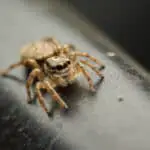Breeding tarantulas may seem like a daunting task, but with the right knowledge and preparation, it can be a rewarding experience. As someone who has successfully bred tarantulas, I can attest that it’s a fascinating process that requires patience and attention to detail. In this article, I will share my tips and insights on how to breed tarantulas, from understanding their behavior to caring for the spiderlings.
Understanding tarantulas is the first step in successfully breeding them. Tarantulas have a unique mating process that involves the male transferring sperm to the female. However, it’s important to note that not all tarantulas are suitable for breeding. It’s crucial to research the species you’re interested in breeding and ensure you have a male and female that are compatible. In addition, you’ll need to create a suitable environment for your tarantulas to ensure they’re healthy and happy. This includes providing the right temperature, humidity, and substrate.
Key Takeaways
- Understanding tarantula behavior is crucial for successful breeding
- Research the species you want to breed and ensure you have a compatible male and female
- Creating a suitable environment is crucial for the health and happiness of your tarantulas

Understanding Tarantulas
Recognizing Different Species
Tarantulas are a diverse group of arachnids, with over 900 species identified so far. These species can vary greatly in size, color, and behavior. Some of the most common species kept as pets include the Chilean rose tarantula, the Mexican redknee tarantula, and the Brazilian black tarantula. It is important to recognize the species of tarantula you are working with, as different species will have different needs and behaviors.
One way to identify tarantula species is through their physical characteristics. For example, the Chilean rose tarantula has a pinkish-red body with long, curly hairs, while the Mexican redknee tarantula has a black body with red knees. Another way to identify tarantula species is through their scientific classification. Tarantulas belong to the family Theraphosidae, which is further divided into subfamilies and genera.
Biology and Behavior
Tarantulas are generally solitary creatures and can be quite territorial. They are also nocturnal, meaning they are most active at night. Tarantulas are known for their impressive size and strength, as well as their venomous bites. However, most tarantula species are not dangerous to humans and will only bite if provoked or threatened.
Breeding tarantulas can be a complex process, as it requires careful attention to the needs and behaviors of both the male and female tarantulas. It is important to ensure that both tarantulas are healthy and well-fed before attempting to breed them. Additionally, it is important to provide a suitable breeding environment, including a suitable substrate and hiding places for the female tarantula.
Overall, understanding the biology and behavior of tarantulas is essential for successful breeding and care. By recognizing different species and their unique needs, as well as understanding their behavior and biology, you can provide the best possible care for your tarantulas.
Preparing for Breeding
Breeding tarantulas can be an exciting and rewarding experience for any arachnid enthusiast. However, it is important to be well-prepared before embarking on this journey. Here are some essential steps to take when preparing for tarantula breeding.
Research
First and foremost, it is crucial to do your research before attempting to breed tarantulas. This includes learning about the specific species you plan to breed, their natural habitat, and their breeding habits. It is also important to understand the risks involved and how to minimize them.
Care and Enclosure
Proper care and housing are essential for healthy and happy tarantulas. Make sure your tarantulas are well-fed, have access to clean water, and are housed in a suitable enclosure. The enclosure should be large enough to accommodate both the male and female tarantulas and provide adequate hiding places.
Temperature and Humidity
Tarantulas are sensitive to temperature and humidity changes. Make sure the temperature and humidity levels in the enclosure are appropriate for the species you plan to breed. This information can be found through research or by consulting with a veterinarian or experienced breeder.
Substrate
The substrate in the enclosure should be appropriate for the species you plan to breed. It should be clean, free of toxins, and provide a suitable environment for the tarantulas to burrow and molt.
Food and Crickets
Feeding your tarantulas a balanced diet is essential for their health and wellbeing. Make sure they have access to a variety of live prey, such as crickets, roaches, and mealworms. It is also important to provide enough food to ensure the female tarantula is well-fed before breeding.
Male Tarantulas
When breeding tarantulas, it is important to have a healthy and mature male tarantula. Make sure the male is well-fed and has not recently molted before introducing him to the female.
Female Tarantulas
Most female tarantulas reach sexual maturity between 3-5 years of age. Make sure the female is well-fed and has not recently molted before breeding. It is also important to monitor her behavior closely during the breeding process to ensure she is not aggressive towards the male.
By following these steps and doing your research, you can increase your chances of a successful tarantula breeding experience.
The Breeding Process
Breeding tarantulas can be a fascinating experience for any arachnid enthusiast. However, it is important to note that tarantulas are solitary creatures, and introducing them to each other can be a risky process. Here are some essential steps to follow to ensure a successful breeding process.
Mating and Courtship
Before breeding, it is essential to ensure that both the male and female tarantulas are mature and healthy. The male tarantula will typically drum against his body with its legs, swaying too and fro, signaling to the female in an act of courtship that he is interested in breeding. The female, if mutually interested, will gesture to the male by tapping her feet at the entrance to her hide.
Sperm Web and Pedipalps
After the courtship process, the male tarantula will deposit a small sperm web on the ground, which he will then transfer to his pedipalps. He will then approach the female, and using his pedipalps, transfer the semen packet into an opening called the opisthosoma in the female’s abdomen.
Receptive Female
It is important to note that not all female tarantulas are receptive to breeding, and introducing an uninterested female to a male tarantula can result in an attack. Female tarantulas are more likely to be receptive to breeding if they have an abundance of food. Therefore, it is essential to feed the female tarantula more food before breeding. A few weeks before you plan to breed her, you need to give her as much food as she wants.
The Mating Process
Once the male has successfully transferred the semen packet, he will quickly leave before the female is no longer welcoming of his presence for mating purposes. After mating, the female will lay eggs within a few weeks, and it is essential to provide her with a suitable environment to lay her eggs.
In conclusion, breeding tarantulas can be a delicate process, and it is essential to take every precaution to ensure a successful breeding process. By following the above steps, you can increase your chances of successfully breeding your tarantulas.
Post Mating Care
After successfully mating your tarantulas, it’s important to provide proper post-mating care to ensure the health and safety of both the female and any potential offspring. Here are some tips to follow:
Remove the Male Tarantula
Once the mating process is complete, it’s essential to remove the male tarantula from the female’s enclosure. Leaving the male in the same enclosure can lead to the female attacking and potentially killing the male.
Provide a Suitable Environment
After mating, the female tarantula may begin to create an egg sac. It’s important to provide a suitable environment for the female to lay her eggs. This can include a burrow or a specially designed container.
Incubation
Once the eggs are laid, it’s important to monitor the incubation process. The temperature and humidity levels should be kept consistent to ensure healthy development.
Laying Eggs
During the egg-laying process, it’s important to avoid disturbing the female tarantula. Any disturbances can cause stress and potentially harm the eggs.
Spermathecae
When examining the female tarantula, it’s essential to look for the presence of spermathecae. This is a small flap with a pinkish color inside and indicates that the female has mated successfully.
Overall, providing proper post-mating care is essential to ensure the health and safety of your tarantulas and any potential offspring. By following these tips, you can increase the chances of a successful breeding experience.
Raising Spiderlings
Breeding tarantulas is an exciting hobby, but it doesn’t stop once the eggs hatch. Raising spiderlings, or slings, can be a challenging but rewarding experience. In this section, I will provide some tips on how to raise spiderlings successfully.
Housing
Spiderlings are tiny and fragile, so they need a suitable enclosure. A vial or baby food jar can be a good option for small spiderlings. A 40 dram vial is recommended for a spiderling that is 1″ (25mm) in legspan. The container should have proper ventilation and a secure lid to prevent escapes.
Feeding
Spiderlings require more frequent feedings than adults. They should be fed small prey items like fruit flies, pinhead crickets, or small mealworms. The prey should be no larger than the spiderling’s opisthosoma (abdomen). Overfeeding can lead to health problems, so it’s essential to monitor the spiderling’s growth and adjust the feeding schedule accordingly.
Temperature and Humidity
Spiderlings require specific temperature and humidity conditions to survive and develop correctly. The ideal temperature range for most tarantula species is between 75-85°F (24-29°C). The humidity level should be kept between 70-80%. A small water dish can help maintain the humidity level.
Handling
Spiderlings are fragile and should be handled with care. It’s best to avoid handling them as much as possible, as stress can harm them. If handling is necessary, make sure to do it gently and with clean hands. Use a soft brush or spoon to move them around if needed.
Survival
Raising spiderlings can be challenging, and not all of them will survive. Some may fail to molt or develop health problems. It’s essential to monitor them closely and take action if necessary. If a spiderling shows signs of illness or stress, it’s best to consult a veterinarian or an experienced tarantula breeder.
In conclusion, raising spiderlings can be a challenging but rewarding experience. By providing suitable housing, proper feeding, temperature and humidity conditions, and careful handling, you can increase their chances of survival and development.
Special Cases in Breeding
Breeding tarantulas can be a challenging and rewarding experience. However, there are some special cases that require extra attention and care. In this section, I will cover some of the most common special cases in tarantula breeding.
Molting
Molting is a crucial process for tarantulas, and it can be a vulnerable time for them. During molting, tarantulas are very fragile and can be easily injured or killed. Therefore, it is important to avoid disturbing them during this time. If you notice that your tarantula is molting, make sure to give it plenty of space and avoid handling it until the process is complete.
Aggression
Tarantulas can be aggressive towards each other, especially during mating. It is important to be patient and observe their behavior carefully. If you notice any signs of aggression, such as one tarantula attacking the other, you should separate them immediately to avoid injury or death.
Captive Breeding
Captive breeding is a popular way to breed tarantulas, but it requires careful attention to detail. You should make sure to provide your tarantulas with a suitable environment and plenty of food and water. You should also be aware of any potential health issues or genetic defects that could affect the offspring.
Mexican Red-Knee and Costa Rican Zebra Tarantulas
Mexican Red-Knee and Costa Rican Zebra tarantulas are two of the most popular pet spiders, and they are also commonly bred in captivity. However, they have different mating habits and require different care. Mexican Red-Knee tarantulas are more aggressive and can be difficult to breed, while Costa Rican Zebra tarantulas are more docile and easier to breed.
In conclusion, breeding tarantulas requires patience, attention to detail, and careful observation of their behavior. By understanding the special cases and taking appropriate measures, you can increase your chances of success and enjoy the rewards of breeding these fascinating creatures.
Conclusion
Breeding tarantulas can be a rewarding experience for spider enthusiasts and breeders alike. With proper care and maintenance, tarantulas can thrive in their habitats and produce healthy specimens for future generations.
As a breeder, it is important to provide a suitable environment for your tarantulas to breed in. This includes ensuring that the female tarantula has an abundance of food before breeding, as well as providing a safe and secure space for the eggs to be laid and incubated.
For spider enthusiasts looking to acquire new specimens for their collections, private breeders and large-scale tarantula farms play a vital role in providing a diverse range of tarantulas to choose from. It is important, however, to only purchase tarantulas from responsible breeding facilities to ensure the health and well-being of the spiders.
Overall, breeding tarantulas requires patience, dedication, and a deep understanding of the care and maintenance required to raise healthy specimens. With the right approach, breeding tarantulas can be a fulfilling and enjoyable experience for both breeders and spider enthusiasts alike.
Frequently Asked Questions
What is the mating process for tarantulas?
The mating process for tarantulas involves introducing a male and female tarantula together. The male will perform a courtship dance to impress the female and then transfer his sperm to the female. The female will then lay eggs, which will hatch into spiderlings.
How long does it take for tarantulas to breed?
The breeding process for tarantulas can take several hours or even days, depending on the species. After mating, it can take several months for the female to lay eggs, which will then hatch into spiderlings.
What are the signs that a tarantula is ready to mate?
The signs that a tarantula is ready to mate include increased activity and appetite in both male and female tarantulas. Male tarantulas may also develop hooks on their front legs and palps, which they use to hold onto the female during mating.
Can breeding tarantulas be profitable?
Breeding tarantulas can be profitable if you have the right species and market. Some species of tarantulas are highly sought after by collectors and can command high prices. However, it is important to research the market and understand the costs involved in breeding and caring for tarantulas.
What are some handleable tarantula species for breeding?
Some handleable tarantula species for breeding include the Chilean rose tarantula, Mexican redknee tarantula, and Brazilian black tarantula. These species are known for their docile nature and ease of handling, making them popular among pet owners and breeders.
How do you care for tarantula eggs during the breeding process?
During the breeding process, it is important to provide a suitable environment for the female to lay her eggs. This includes a substrate for the eggs to be laid in and a humid environment to prevent the eggs from drying out. Once the eggs have been laid, they should be kept in a separate container and monitored closely until they hatch.








